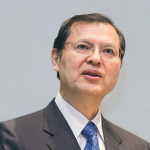
The concluding chapters of volume 30 of The New Human Revolution describe the development of kosen-rufu from 1981 to 2001, a 20-year period that Shin’ichi Yamamoto dedicates to encouraging and training young people, and building the foundation for worldwide kosen-rufu.
The “Cheers of Victory” chapter opens with Shin’ichi—having just returned from a 61-day guidance tour across the Northern hemisphere—sending a congratulatory message to the youth division general meeting marking the 30th anniversary of the founding of the young men’s and young women’s divisions. And the final chapter, “Vow,” concludes with a scene from the headquarters leaders meeting commemorating the 50th anniversary of these divisions. The fact that the last two chapters of the entire series begin and end with Shin’ichi’s encouragement to youth clearly evidences his profound commitment to fostering young people during this 20-year period.
In November 1981, Shin’ichi visits the Shikoku Region where members had suffered deeply from the Nichiren Shoshu priests’ abusive remarks since the start of the first priesthood issue [in the 1970s]. Upon the request of the Shikoku young men’s division, he agrees to review and offer revisions to the lyrics of a song they had composed. Finally, after reworking it some 20 or more times, the “Song of Crimson” is completed.
In December, Shin’ichi visits Oita Prefecture where the members had also endured great hardship in the face of the continued plotting and scheming of local priests to have members leave the Soka Gakkai. There, at a youth division prefectural leaders meeting, he presents “Youth, Scale the Mountain of Kosen-rufu of the 21st Century,” a poem he had composed for the occasion. In it, he declares that their struggles up until May 3, 2001, will determine the outcome of the second phase of kosen-rufu. To that end, he calls on them to continue to exert themselves earnestly in their Buddhist practice.
During 1981, Shin’ichi launches a series of full-fledged initiatives to accelerate the advancement of worldwide kosen-rufu in spite of, and in response to, Nichiren Shoshu’s unwarranted attacks on the Soka Gakkai. He had “waited for and created the time to usher in the dawn of a new age”[1] by focusing his attention and energies on fostering youth.
This year—July 2021—marked the 70th anniversary of the young men’s and young women’s divisions. In his message to their respective commemorative meetings, Ikeda Sensei called on the young men to broaden their network of people who embody the Buddhist principle of “from the indigo, an even deeper blue”[2] and encouraged the young women to expand their solidarity with the brilliance of the rising sun.
In the “Cheers of Victory” chapter, Shin’ichi calls out to the youth in his heart: “I am entrusting you with the Soka Gakkai, kosen-rufu, the world and the 21st century!”[3] Following the lead of the young people who are opening a new era in the history of our movement, let us respond to our mentor’s call by strengthening four-divisional unity and striving together to nurture the youth and future divisions, giving rise to a robust network of Soka youth.
Building a Rock-Solid Foundation
The two decades detailed in the latter half of volume 30 are also a period in which the Soka Gakkai makes great advances as a global religious movement. As SGI President, Shin’ichi travels around the world, meeting with fellow members and forging bonds of mentor and disciple in Buddhism.
He also finds himself the recipient of various awards and commendations, which include the titles of Poet Laureate from the World Academy of Arts and Culture (in 1981) and World Poet Laureate from the World Poetry Society Intercontinental (in 1995), a number of national honors, as well as honorary degrees and titles from universities and institutions around the world. To Shin’ichi, these are “recognitions of the SGI’s efforts for peace, culture and education, as well as affirmation of the praise and trust members of each country had won through their contributions to society.”[4]
Throughout these 20 years, Shin’ichi also pours his energies into meeting and engaging in dialogue with leaders of numerous countries. He is confident that such actions will not only help pave the way to realizing world peace and promote understanding of the Soka Gakkai but will also protect the members living in those countries.
As the currents of worldwide kosen-rufu continue to build momentum, the Soka Gakkai is confronted with a second priesthood issue [in 1990 and 1991]. Even in the aftermath of the first priesthood issue, Shin’ichi had remained steadfast in his efforts to promote harmonious relations between the Soka Gakkai and the priesthood and strove in every way possible to support them for the sake of kosen-rufu. Despite these efforts, Nichiren Shoshu continued to embody the Lotus Sutra passage “evil demons will take possession” (The Lotus Sutra and Its Opening and Closing Sutras, p. 233), and, having revealed its domineering attitude toward the lay believers, ultimately “cut itself off from the Soka Gakkai.”[5]
For their part, members of the Soka Gakkai had been able to calmly see through the priesthood’s unscrupulous schemes. Burning with a passion to refute the erroneous and reveal the true, they dauntlessly challenged themselves in their Buddhist practice. I believe this was made possible, in part, due to Shin’ichi’s efforts to keep sending them encouragement. He was ready to stake his life for the members.
The “Vow” chapter describes how, following the first priesthood issue, Shin’ichi exerted himself “to build, once again, a rock-solid Soka Gakkai united by the bonds of mentor and disciples dedicated to the mission of kosen-rufu.” It continues:
As a result of these efforts, young successors were showing splendid development, and a great bastion of Soka was being built—united by indestructible ties of mentor and disciple that would remain fast and strong, even amid the harshest adversity.[6]
This mentor-disciple relationship came to be embraced by members not only in Japan but throughout the world.
This year marks the 30th anniversary of our spiritual independence from Nichiren Shoshu, when the Soka Gakkai cast off the chains of an authoritarian priesthood. Today, our network of Soka spans 192 countries and territories. Faced with multiple international crises such as a global pandemic and climate change, it is time for members throughout the world to “unite in a grassroots effort to create a new powerful momentum for peace.”[7]
A Single True Disciple
The final scene of volume 30 describes a moment during the November 2001 Headquarters Leaders Meeting when Shin’ichi calls out to the youth in his heart: “Let’s set forth together! As long as we live, let’s fight! Let’s advance with confidence and vigor as we vibrantly ring in the second series of Seven Bells!”[8]
In the same chapter, we also find the following:
The great undertaking of kosen-rufu cannot be accomplished in a single lifetime. It can only be achieved when that mission is passed on from the mentor to the disciples, who in turn pass it on to the disciples of future generations.[9]
As these lines suggest, I believe Sensei concludes the novel by entrusting his young disciples with the mission of realizing the vision for kosen-rufu set forth in the second series of Seven Bells.
The first series of Seven Bells refers to seven consecutive seven-year periods in the Soka Gakkai’s development, from its founding in 1930 through 1979. During this period, Shin’ichi succeeds in making first and second Soka Gakkai presidents Tsunesaburo Makiguchi and Josei Toda’s visions a reality, marking significant milestones in the development of the Soka Gakkai every seven years.
The second series of Seven Bells begins in 2001. In the second seven-year period [from 2008 through 2014], the Hall of the Great Vow for Kosen-rufu is completed (2013) and the disciples of Sensei throughout the globe unite in spirit to create a new era of worldwide kosen-rufu.
During the third seven-year period [from 2015 through 2021], the Soka Gakkai solidifies its organizational structure as a world religion and Sensei finishes writing The New Human Revolution (2018).
Next year, 2022, will mark the start of the fourth seven-year period, and the year 2050—when the Soka Gakkai celebrates its 120th anniversary—will mark the completion of the second series of Seven Bells. In my view, this second series of Seven Bells offers a shared vision and direction around which Sensei’s disciples can unite and advance.
In the final chapter of volume 30, Shin’ichi introduces the following words of his mentor, President Toda: “As long as there is a core of youth—no, even a single true disciple—we will achieve kosen-rufu.”[10] Every endeavor begins with a single earnest and committed individual. Toward the Soka Gakkai’s centennial in 2030, let us each rise to our potential as “a single true disciple” and achieve a splendid personal history of human revolution.
Translated from the July 28, 2021, Seikyo Shimbun, the Soka Gakkai’s daily newspaper.
Summary of Contents
 Bells of Dawn—Part 2
Bells of Dawn—Part 2
Shin’ichi Yamamoto visits the United States and Canada.
Cheers of Victory
Shin’ichi composes the “Song of Crimson” in Shikoku. He composes the poem “Youth, Scale the Mountain of Kosen-rufu of the 21st Century” in Oita, Kyushu. Members throughout Japan rejoice in hearing these refreshing melodies.
Vow
Shin’ichi conducts a series of dialogues with world leaders and intellectuals. The Soka Gakkai prepares to face the 21st century, with the vision of developing into a truly global religious movement.
This book is available at https://bookstore.sgi-usa.org.
References
- The New Human Revolution, vol. 30, p. 453. ↩︎
- “Hell Is the Land of Tranquil Light,” The Writings of Nichiren Daishonin, vol. 1, p. 457. ↩︎
- The New Human Revolution, vol. 30, p. 590. ↩︎
- Ibid., pp. 644–45. ↩︎
- Ibid., p. 728. ↩︎
- Ibid., p. 706. ↩︎
- Ibid., p. 824. ↩︎
- Ibid., p. 826. ↩︎
- Ibid., pp. 824–25. ↩︎
- Ibid., p. 825. ↩︎
You are reading {{ meterCount }} of {{ meterMax }} free premium articles

